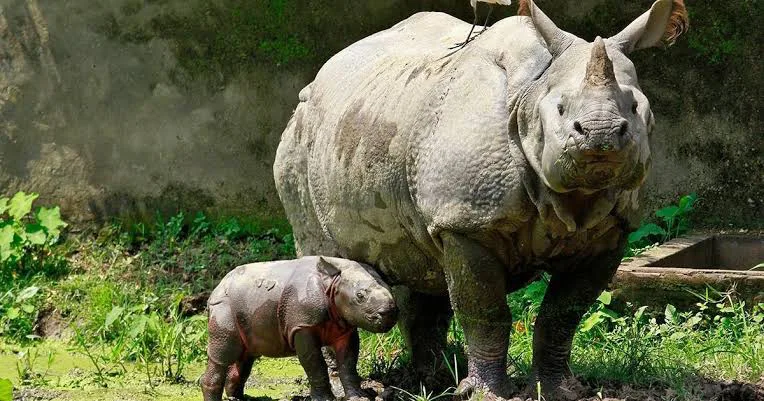lettersforvivian.org – The Indian rhinoceros (Rhinoceros unicornis), also known as the greater one-horned rhinoceros, is a magnificent creature native to the Indian subcontinent. Characterized by its single horn and thick, armor-like skin, this rhino species has faced significant threats but has also demonstrated remarkable resilience through dedicated conservation efforts. This article explores the world of the Indian rhinoceros, examining its biology, behavior, ecological role, and the ongoing challenges it faces.
Taxonomy and Physical Characteristics: Distinctive Features
The Indian rhinoceros is one of five extant rhinoceros species and is the only member of the genus Rhinoceros. Key physical characteristics include:
- Large Size and Powerful Build: Indian rhinos are among the largest land mammals, with males weighing up to 2,200 kg (4,900 lb) and females weighing up to 1,600 kg (3,500 lb). They have a stocky build and short, sturdy legs.
- Single Horn: Their most distinctive feature is their single horn, which is made of keratin (the same material as human fingernails). The horn can grow up to 60 cm (24 in) long.
- Thick, Armor-like Skin: Their thick skin is folded into prominent plates, giving them an armor-plated appearance. The skin is grayish-brown in color.
- Prehensile Upper Lip: They have a prehensile upper lip, which they use for grasping vegetation.
Behavior and Social Structure: Solitary but with Social Interactions
Indian rhinos are generally solitary animals, except for mothers and their calves.
- Territoriality: Males establish and defend territories, which they mark with urine, dung heaps (middens), and by scraping their feet.
- Social Interactions: While generally solitary, they do interact with each other at waterholes and grazing areas.
- Grazing Behavior: They are primarily grazers, feeding on grasses, leaves, fruits, and aquatic plants.
- Wallowing: They frequently wallow in mud or water, which helps them to regulate their body temperature and protect their skin from insects and parasites.
Ecological Role: Shaping Grassland and Wetland Ecosystems
Indian rhinos play a crucial role in maintaining the health of grassland and wetland ecosystems.
- Grazing Impact: Their grazing influences vegetation structure and composition.
- Seed Dispersal: They can contribute to seed dispersal by consuming fruits and then depositing the seeds in their dung.
- Habitat Creation: Their wallowing creates wallows, which provide habitat for other species.
Threats and Conservation: A Conservation Success Story with Ongoing Challenges
The Indian rhinoceros has a complex conservation history. Once on the brink of extinction, their numbers have rebounded thanks to dedicated conservation efforts. However, they still face significant threats:
- Historical Hunting and Habitat Loss: In the past, they were heavily hunted for sport and their horns, and their habitat was significantly reduced due to human development and agriculture.
- Poaching: Poaching for their horns, which are highly valued in traditional medicine in some Asian countries, remains a major threat.
- Habitat Loss and Fragmentation: Habitat loss and fragmentation due to human activities continue to threaten their populations.
- Human-Wildlife Conflict: Conflicts with humans arise when rhinos stray into agricultural areas or human settlements.
Conservation efforts have been crucial for the recovery of the Indian rhinoceros:
- Strict Protection and Law Enforcement: Strict protection under national and international laws has been essential in combating poaching.
- Protected Areas: Establishing and managing protected areas, such as national parks and wildlife sanctuaries, is crucial for conserving rhino habitats.
- Translocation and Reintroduction: Translocating rhinos to new areas or reintroducing them to areas where they have become locally extinct has helped to establish new populations.
- Community Conservation: Working with local communities to promote coexistence and reduce human-wildlife conflict is crucial.
- Monitoring and Research: Ongoing research and monitoring are needed to understand rhino populations, behavior, and the threats they face.
Current Population and Distribution: A Conservation Success
Thanks to successful conservation efforts, the Indian rhinoceros population has increased significantly in recent decades. The majority of the population is found in India, with smaller populations in Nepal. Kaziranga National Park in India is home to the largest population of Indian rhinos in the world.
Conclusion: A Symbol of Conservation Success and Continued Vigilance
The Indian rhinoceros stands as a symbol of conservation success, demonstrating that dedicated efforts can bring a species back from the brink of extinction. However, the threat of poaching and habitat loss remains, requiring continued vigilance and sustained conservation action. Maintaining strict protection, combating poaching, protecting and restoring habitats, and promoting coexistence with local communities are essential to ensure the long-term survival of this magnificent one-horned giant. Protecting the Indian rhinoceros is not just about preserving a species; it’s about safeguarding the rich biodiversity of the Indian subcontinent and recognizing the interconnectedness of all life.

